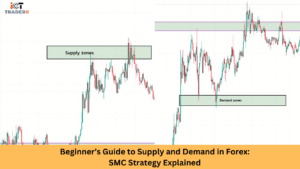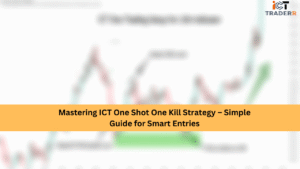Are you tired of using multiple trading strategies and still not getting consistent results? If so, the ICT One Trade Setup for Life might be exactly what you need. This single, powerful setup is designed to help you win consistently by following a structured approach used by professional traders.
In this article, you will learn how it works, how to apply it, and how to avoid common mistakes.
What is the ICT One Trade Setup for Life?
The ICT (Inner Circle Trader) One Trade Setup for Life is a repeatable, rule-based strategy created by Michael J. Huddleston, the founder of ICT concepts. It’s built on smart money principles, meaning it focuses on how institutional traders move the market.
Instead of trading randomly, this setup helps you find one high-probability trade per day, using concepts like:
- Market bias
- Liquidity hunts
- Market structure shifts
- Fair Value Gaps (FVGs)
- Session timing
It’s called “One Trade Setup for Life” because once you master it, you don’t need any other strategy. It gives you structure, clarity, and consistency — and you don’t have to sit in front of charts all day.
Key Components of This Setup
To make this work, you need to understand a few core elements:
- Daily Bias
This means identifying whether the market is likely to move up (bullish) or down (bearish) for the day. You determine this by analyzing higher timeframes, such as the daily and 4-hour charts. - Liquidity
Price often moves toward areas where traders have placed stop-losses. These are known as liquidity pools, and the market loves to hit them before reversing. The ICT setup uses this concept to predict where the price will turn. - Market Structure Shift (MSS)
After the market absorbs liquidity, it typically exhibits a clear shift in market structure, signaling that the direction has changed. This is your green light for entering a trade. - Fair Value Gaps (FVGs)
These are gaps in price that occur when the market moves quickly. After a liquidity grab and MSS, the price often comes back to fill the gap. That’s your ideal entry zone. - Session Timing
ICT trades are usually based on New York time zones, especially the London and New York sessions. These are the most active and offer the best trade setups.
Step-by-Step Breakdown of the Trade Setup
Let’s break this strategy down so you can use it immediately:
1. Set Your Time Zone
Make sure your chart is set to New York time. All ICT concepts are based on this.
2. Find Your Daily Bias
Look at the daily and 4H charts. Ask yourself: “Is the market likely to move higher or lower today?” Use tools like swing highs/lows, trend direction, and recent price action.
3. Wait for Liquidity Hunt
During the London or New York session, wait for the market to reach above a key high (buy-side liquidity) or below a key low (sell-side liquidity). This is where most retail traders get stopped out — and where smart traders start looking to enter.
4. Watch for a Market Structure Shift (MSS)
After the liquidity grab, wait for the price to shift structure, like breaking a recent high in a bearish move or breaking a recent low in a bullish move. This confirms that the market is reversing.
5. Look for a Fair Value Gap (FVG)
Once you see a structure shift, wait for the price to return to the FVG (the imbalance area). This is your perfect entry zone.
6. Enter the Trade
Enter on the FVG, place your stop-loss just below the liquidity level that was taken, and target a logical level (like a previous high or low, or next liquidity zone).
Best Time to Use This Setup
The most effective times to use this setup are:
- London Kill Zone: 2 AM – 5 AM New York Time
- New York Kill Zone: 8:30 AM – 11:00 AM New York Time
- Lunch Time Liquidity: 12 PM – 1:30 PM
These are the times when the market is most active and liquidity-based setups are easiest to find. If you focus on just one trade during these hours, you will avoid overtrading and find more success.
Common Mistakes to Avoid
Even though this setup is powerful, some traders still make mistakes. Here’s what you should watch out for:
- Skipping Daily Bias: Never trade without first knowing whether you’re bullish or bearish for the day. Trading against the bias lowers your win rate.
- Entering Too Early: Always wait for the liquidity grab and the market structure shift. If you jump in early, you’re likely to get stopped out.
- Ignoring Time Zones: If you’re not trading during the London or New York session, this setup won’t work well.
- Chasing Missed Moves: If the trade setup is gone, don’t force an entry. Wait for the next session or day.
- Overtrading: The power of this strategy is in its simplicity. Stick to one quality trade per day.
Conclusion
The ICT One Trade Setup for Life isn’t just another trading technique — it’s a complete mindset. With just one setup, one structure, and one process, you can build a career in trading.
By using this setup:
- You eliminate guesswork
- You trade with the smart money.
- You stay patient, focused, and consistent.t
All you need to do is master the pattern, follow the process, and stop jumping from one strategy to another. The market repeats itself every day — and once you recognize the pattern, you’ll start winning.
FAQs
Is this setup only for forex?
No. While it works best in forex due to high liquidity, you can also apply it to indices (like S&P 500), gold, and even crypto.
How long does it take to master this strategy?
It depends on your dedication. Some traders understand it in a few weeks with practice and journaling, while others may take a few months.
Can beginners use this setup?
Absolutely! But you’ll need to spend time learning the concepts and practicing them on demo accounts before going live.
Do I need any indicators?
No indicators are required. ICT setups are based purely on price action, time, and liquidity zones.
You now have a full, simplified guide to the ICT One Trade Setup for Life. Start applying it, stay consistent, and let this one strategy change how you trade forever.



